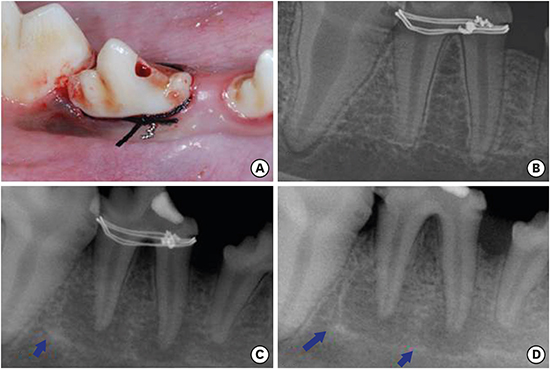INTRODUCTION
MATERIALS AND METHODS
Animals
 | Figure 1Outline of study: unilateral mandibular 4th premolar teeth in 5 dogs served as experimental units subject to induction of periodontal/endodontic pathology following pulp exposure and ligature enhanced plaque accumulation prior to extraction and subsequent healing (diseased extraction sites). Contralateral 4th premolar teeth served as healthy controls (fresh extraction sites). Block biopsies of the experimental and control sites were obtained at days 1, 7, 30, 60, and 90 post-extraction. |
Surgical protocol
Postoperative procedures
Sample size calculation
Radiographic recordings
Histologic processing
Scanning electron microscopy
Histopathologic analysis
RESULTS
Radiographic observations
Scanning electron microscopy observations
 | Figure 3Scanning electron microscopy observation of the apical portion of the alveolar socket walls immediately after extraction of diseased (B) and non-diseased extraction sockets (A). Evidence of Volkmann canals closure in diseased sites suggest deterioration of vascular supply in the infected areas possibly affecting bone remodeling. |
Histopathologic observations
Table 1
Comparisons of the proportion of tissue components in the healthy and diseased extraction sites over a 90-day healing interval (mean±SD in %)

Day 1
 | Figure 4Overview of fresh (A) and diseased (C) extraction sites day 1. Note large inflammatory cell infiltration coronally and apically in the diseased site (C). Also, note severed periodontal ligament in both groups (B, D). The periodontal ligament aligned perpendicular to the bundle bone in the fresh extraction sites (B: white arrow) whereas alignment appeared parallel to the extraction socket wall (D: white arrow) in the diseased sites. Osteoclast-like cell activity (blue arrows). H&E, original magnification ×16 and ×200.
I-cells: inflammatory cells, CLOT: fibrin clot, PDL: periodontal ligament, BB: bundle bone, H&E: hematoxylin and eosin.
|
Day 7
 | Figure 5Overview of fresh (A) and diseased (C) extraction sites day 7. Note resorption of the socket wall in the diseased site (C). Also, note mineral deposition (white arrows) and pronounced osteoclast-like cells (blue arrows) in fresh (B) and diseased (D) sites at a higher magnification. H&E, original magnification ×16 and ×200.
CLOT: fibrin clot, FT: fibrous connective tissue, BB: bundle bone, H&E: hematoxylin and eosin.
|
Day 30
 | Figure 6Overview of fresh extraction sites day 30 (A) and 60 (C) and diseased extraction sites day 30 (B) and 60 (D). Note fibrous connective tissue remaining in the central part of the diseased site day 30 (B) and larger portion of bone trabeculae remaining in the central part of the diseased site day 60 (D). H&E, original magnification ×16.
H&E: hematoxylin and eosin.
|
Day 60
Day 90
 | Figure 7Overview of fresh (A) and diseased (C) extraction sites day 90. Note the greater quantity of mature bone marrow formation at (A) vs. delayed healing and retained bone trabeculae at (C). Also, note cortical bone bridge at fresh (B) and diseased (D) extraction sites day 90. Note reversal line between pristine and new bone (white arrows). H&E, original magnification ×16 and ×200.
H&E: hematoxylin and eosin.
|




 PDF
PDF ePub
ePub Citation
Citation Print
Print





 XML Download
XML Download